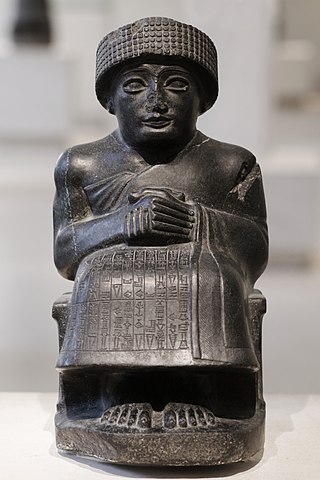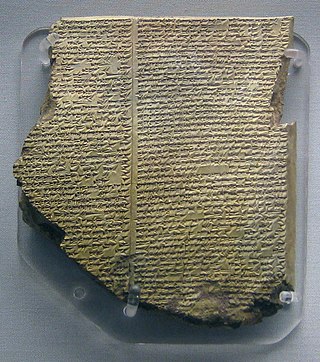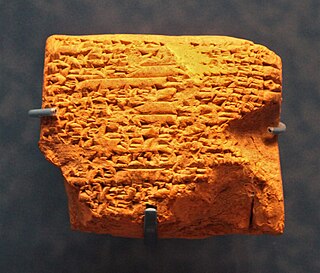
Gilgamesh was a hero in ancient Mesopotamian mythology and the protagonist of the Epic of Gilgamesh, an epic poem written in Akkadian during the late 2nd millennium BC. He was possibly a historical king of the Sumerian city-state of Uruk, who was posthumously deified. His rule probably would have taken place sometime in the beginning of the Early Dynastic Period, c. 2900 – 2350 BC, though he became a major figure in Sumerian legend during the Third Dynasty of Ur.

Inanna is the ancient Mesopotamian goddess of love, war, and fertility. She is also associated with sensuality, procreation, divine law, and political power. Originally worshipped in Sumer, she was known by the Akkadian Empire, Babylonians, and Assyrians as Ishtar. Her primary title is "the Queen of Heaven".

The history of Sumer spans the 5th to 3rd millennia BCE in southern Mesopotamia, and is taken to include the prehistoric Ubaid and Uruk periods. Sumer was the region's earliest known civilization and ended with the downfall of the Third Dynasty of Ur around 2004 BCE. It was followed by a transitional period of Amorite states before the rise of Babylonia in the 18th century BCE.

The Epic of Gilgamesh is an epic from ancient Mesopotamia. The literary history of Gilgamesh begins with five Sumerian poems about Gilgamesh, king of Uruk, some of which may date back to the Third Dynasty of Ur. These independent stories were later used as source material for a combined epic in Akkadian. The first surviving version of this combined epic, known as the "Old Babylonian" version, dates back to the 18th century BC and is titled after its incipit, Shūtur eli sharrī. Only a few tablets of it have survived. The later Standard Babylonian version compiled by Sîn-lēqi-unninni dates to somewhere between the 13th to the 10th centuries BC and bears the incipit Sha naqba īmuru. Approximately two-thirds of this longer, twelve-tablet version have been recovered. Some of the best copies were discovered in the library ruins of the 7th-century BC Assyrian king Ashurbanipal.

Shamash, also known as Utu was the ancient Mesopotamian sun god. He was believed to see everything that happened in the world every day, and was therefore responsible for justice and protection of travelers. As a divine judge, he could be associated with the underworld. Additionally, he could serve as the god of divination, typically alongside the weather god Adad. While he was universally regarded as one of the primary gods, he was particularly venerated in Sippar and Larsa. The moon god Nanna (Sin) and his wife Ningal were regarded as his parents, while his twin sister was Inanna (Ishtar). Occasionally other goddesses, such as Manzat and Pinikir, could be regarded as his sisters too. The dawn goddess Aya (Sherida) was his wife, and multiple texts describe their daily reunions taking place on a mountain where the sun was believed to set. Among their children were Kittum, the personification of truth, dream deities such as Mamu, as well as the god Ishum. Utu's name could be used to write the names of many foreign solar deities logographically. The connection between him and the Hurrian solar god Shimige is particularly well attested, and the latter could be associated with Aya as well.

Humbaba, originally known as Ḫuwawa in Sumerian, was a figure in Mesopotamian mythology. The origin and meaning of his name are unknown. He was portrayed as an anthropomorphic figure comparable to an ogre or giant. He is best known from Sumerian and Akkadian narratives focused on the hero Gilgamesh, including short compositions belonging to the curriculum of scribal schools, various versions of the Epic of Gilgamesh, and several Hurrian and Hittite adaptations. He is invariably portrayed as the inhabitant or guardian of the cedar forest, to which Gilgamesh ventures with his companion Enkidu. The subsequent encounter leads to the death of Humbaba, which provokes the anger of the gods. Humbaba is also attested in other works of Mesopotamian literature. Multiple depictions of him have also been identified, including combat scenes and apotropaic clay heads.

Lugalbanda was a deified Sumerian king of Uruk who, according to various sources of Mesopotamian literature, was the father of Gilgamesh. Early sources mention his consort Ninsun and his heroic deeds in an expedition to Aratta by King Enmerkar.

Ninsun was a Mesopotamian goddess. She is best known as the mother of the hero Gilgamesh and wife of deified legendary king Lugalbanda, and appears in this role in most versions of the Epic of Gilgamesh. She was associated with Uruk, where she lives in this composition, but she was also worshiped in other cities of ancient Mesopotamia, such as Nippur and Ur, and her main cult center was the settlement KI.KALki.

Aratta is a land that appears in Sumerian myths surrounding Enmerkar and Lugalbanda, two early and possibly mythical kings of Uruk also mentioned on the Sumerian king list.

Enmerkar was an ancient Sumerian ruler to whom the construction of the city of Uruk and a 420-year reign was attributed. According to literary sources, he led various campaigns against the land of Aratta.

Enmerkar and the Lord of Aratta is a legendary Sumerian account, preserved in early post-Sumerian copies, composed in the Neo-Sumerian period . It is one of a series of accounts describing the conflicts between Enmerkar, king of Unug-Kulaba, and the unnamed king of Aratta.

Hamazi or Khamazi was an ancient kingdom or city-state which became prominent during the Early Dynastic period. Its exact location is unknown.

Sumerian literature constitutes the earliest known corpus of recorded literature, including the religious writings and other traditional stories maintained by the Sumerian civilization and largely preserved by the later Akkadian and Babylonian empires. These records were written in the Sumerian language in the 3rd and 2nd millennia BC during the Middle Bronze Age.

Dumuzid, titled the Fisherman, was a legendary Sumerian king of Uruk listed originating from Kuara. According to legend, in the one-hundredth year of his reign, he was captured by Enmebaragesi.
Lugalbanda and the Anzu Bird is a Sumerian mythological account. The story is the second of two about the hero Lugalbanda. The first story is known as Lugalbanda in the Mountain Cave, or sometimes Lugalbanda in the Wilderness. They are part of a four-story cycle that describes the conflicts between Enmerkar, king of Unug (Uruk), and the king of Aratta. The texts are believed to be composed during the Ur III Period, but almost all of the extant copies come from Isin-Larsa period. Nevertheless, a few fragmentary bilingual copies from Nineveh suggest that the texts were still known during the first millennium.

The Sumerian disputation poem or Sumerian debate is a genre of Sumerian literature in the form of a disputation. Extant compositions from this genre date to the middle-to-late 3rd millennium BC. There are six primary poems belonging to this genre. The genre of Sumerian disputations also differs from Aesopic disputations as the former contain only dialogue without narration. In their own language, the texts are described as adamin in the doxologies at the end of the poem, which literally means "contests (between) two".
Gilgamesh, Enkidu, and the Netherworld is one of five extant compositions of the Sumerian language about the deeds of the hero Gilgamesh. It was known to the ancients by its incipit, ud ri-a ud sud-rá ri-a or "In those days, in those faraway days". It spans 330 lines.

Gilgamesh and Aga, sometimes referred to as incipit The envoys of Aga, is an Old Babylonian poem written in Sumerian. The only one of the five poems of Gilgamesh that has no mythological aspects, it has been the subject of discussion since its publication in 1935 and later translation in 1949.
Tale of Gudam, also known as the Gudam Epic or Inanna and Gudam, is a Mesopotamian myth known from two Old Babylonian copies from Nippur. It tells the tale of Gudam, an otherwise unknown character, who goes on a rampage in Uruk. The minstrel Lugalgabagal criticizes his behavior, but his remarks only enrage him more. He is finally stopped by a fisherman of Inanna. The goddess herself subsequently decides to spare his life when he starts pleading, and sends him to live in a ditch near Zabalam. Many aspects of the story are a subject of debate in Assyriology, including the nature of Gudam and the identity of the fisherman. Possible connections between the Tale of Gudam and other texts have also been noted. In particular, Gilgamesh and the Bull of Heaven is considered a close parallel, with some authors outright considering the two texts to be variants of one narrative.

















